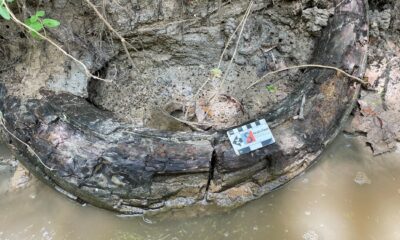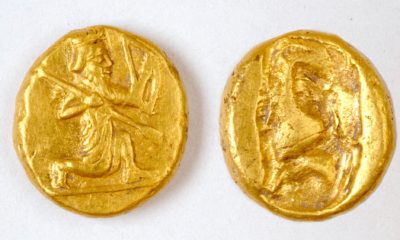Technology
This giant arctic reptile once stalked an ancient superocean

In today’s oceans, sea turtles, marine iguanas, saltwater crocodiles and sea snakes are the main reptilian inhabitants, in addition to the enormous number of mammals and fish. This was not always the case, as fossil evidence shows that reptiles dominated the seas about 252 million years ago. Now an international team of scientists has put together a new piece of this puzzle and identified the oldest fossil of a sea-dwelling reptile in the Southern Hemisphere. The vertebra fossil belonged to the sea dragon-like nothosaurus and was found in a streambed on New Zealand’s South Island. The findings are described in a study published June 17 in the journal Current biology.
[Related: New species of extinct marine reptile found with help from 11-year-old child.]
When reptiles ruled the seas
Millions of years before dinosaurs roamed the Earth, reptiles were the kings of Earth’s seas.
The most diverse and geologically longest-lived group of these extinct marine reptiles are the sauropterygians. They have an evolutionary history of more than 180 million years. Sauropterygians included the long-necked plesiosaurs–which resembled the popular image of the Loch Ness Monster.
The nothosaur was a distant ancestor of the plesiosaurs. They were about 23 feet long and used four paddle-like limbs for swimming and flattened skulls with slender cone-shaped teeth in their mouths that were used to catch fish and squid.
The nothosaurus vertebra found in this study dates back to the time when present-day New Zealand was located on the southern polar coast of a vast superocean called Panthalassa. When a mass extinction called the Great Dying devastated marine ecosystems about 250 million years ago, surviving reptiles found opportunity in Earth’s oceans.
Scientists have found evidence for this evolutionary benchmark on the Arctic island Spitsbergen, northwestern North America and southwestern China. This single nothosaur vertebra fossil in the study is one of the latest finds from this period and could shed new light on the history of ancient marine reptiles of the Southern Hemisphere.
A new look at an old fossil
The New Zealand nothosaur was initially discovered during a geological survey in 1978, embedded in a boulder in a stream at the foot of Mount Harper on New Zealand’s South Island. The importance of this was only fully appreciated when a team of paleontologists from Australia, East Timor, Norway, New Zealand and Sweden worked together to examine and analyze the vertebrae and other fossils.
“The nothosaur found in New Zealand is more than 40 million years older than the previously oldest known sauropterygian fossils from the Southern Hemisphere,” Benjamin Kear, co-author and paleontologist from the Museum of Evolution at Uppsala University in Sweden, said in a statement. “We show that these ancient marine reptiles lived in a shallow coastal environment teeming with marine life within what was then the Southern Arctic Circle.”

The oldest known nothosaur fossils are about 248 million years old. They are found mainly along an ancient low-latitude northern belt that extended from the remote northeastern to northwestern margin of the Panthalassa superocean.
Surfing the Panthalassa Super Ocean
Paleontologists still are debate the origin, distribution, and timing of when nothosaurs reached these distant areas. Some prevailing theories suggest that they either migrated along the northern Arctic coasts, swam through the inland sea, or used currents to cross the ocean. Panthalassa superocean. Now this new nothosaurus fossil throws some cold water on these hypotheses.
“Using a time-calibrated evolutionary model of sauropterygian global distributions, we show that nothosaurs originated near the equator and then rapidly spread both north and south, at the same time that complex marine ecosystems were recovering after the cataclysmic mass extinction that marked the beginning. of the age of the dinosaurs,” Kear said.
[Related: This Jurassic-era ‘sea murderer’ was among the first of its kind.]
When the Age of Dinosaurs began, the Earth was experiencing an extreme period of global warming. Warm temperatures allowed these marine reptiles to thrive at Earth’s south pole. Kear and the team believe this indicates that the ancient polar regions were likely the main route for the first global migration of the nothosaurus. This is similar to the incredibly long one migrations that today’s whales undertake.
More research is needed to confirm this and this will only be possible by unearthing more remains of this ancient sea dragon.
“No doubt there are more fossil remains of long-extinct sea monsters waiting to be discovered in New Zealand and elsewhere in the Southern Hemisphere,” says Kear.











